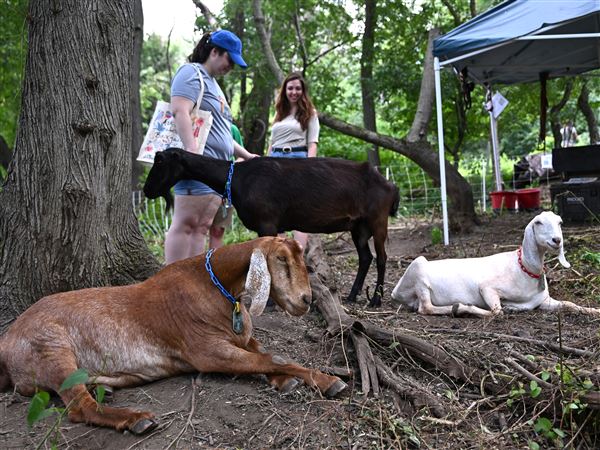Lizzy, an American foxhound, is indifferent to the many dogs she sees at the South Park Dog Park. But when she met a handsome young German shorthaired pointer named Zeiger, “it was love at first sight,” for both dogs, insists Kelly Schreffler, who posted a picture of “their first kiss” on Facebook.
Many people want to know, “Do dogs fall in love?” In the days leading up to Valentines Day, that question in the Google search engine produced 95,000 hits.
Psychologists, neuropsychologists, veterinarians and other scientists have studied canine emotions and behavior for decades.
“Do Dogs Fall in Love?” is the title of an article in the February “Your Dog” newsletter published by the Cummings School of Veterinary Medicine at Tufts University. Veterinarian Nicholas Dodman, who runs the school’s Animal Behavior Clinic, says oxytocin plays a role.
Sometimes called ”the love hormone,” oxytocin is secreted by dogs and people. Oxytocin is released when a baby passes through the birth canal and when a baby nurses. Some animals release it during mating.
“A female dog releases a surge of oxytocin when she returns to her puppies, and the puppies have a surge when their mom comes back,” said Stanley Coren, who has a PhD in neuropsychology and has been studying people, dogs and the human-canine bond since the 1960s.
The presence of oxytocin in dogs can be measured by blood samples or mouth swabs,” Mr. Coren, a Philadelphia native and a professor emeritus at the University of British Columbia in Vancouver, Canada, said.
Mr. Coren believes that some dogs love other dogs, but thinks ”it’s more of a family love, than romantic love. It’s like the love between parents and children.”
Many dogs show special love or affection for dogs of their own breed — or dogs that look like them, he said. That goes back to when they were very young puppies.
“They look around and what do they see? Mom and puppies that look just like them,” Mr. Coren said.
Dare we call that ”puppy love,” though it’s not a term used by Mr. Coren. He has seen special bonds in his own household.
Years ago he added a Nova Scotia duck tolling retriever puppy, Dancer, to his family, which included a black flat-coated retriever named Oden.
“Dancer spent his whole life with Oden” and when the older dog died, the younger dog whimpered and continually looked for Oden throughout the house. “Dancer was inconsolable, and for the rest of his life he rushed up to every long-coated black dog he saw,” Mr. Coren said.
At the Behavior Clinic at Tufts, Mr. Dodman has treated many dogs for depression caused by the death of a dog they loved.
“A dog had died of cancer and was buried in the family’s yard. The other dog became hysterical and sat on the grave for two days, completely shut down,” Dr. Dodman said. “I’ve seen a number of dogs with depression. You can not have depression without a strong bond.”
He asked his wife Linda Breitman if dogs fall in love.
“She’s a veterinarian, and very clever. She said of course dogs can fall in love,” he said.
They see it at home, where their dogs Rusty, a boxer-Rhodesian ridgeback mix, and Jasper,”some kind of hound,” cuddle and groom each other “and just dote on each other,” Dr. Dodman said.
Many dog experts generally agree that dogs have the emotions and communication ability of a two-year-old child, Mr. Coren said.
Dogs — and two-year-old children — “do not have more complex emotions, like pride and guilt.” Guilt doesn’t show up in humans until the age of 4 or 5, and ”romantic love” does not manifest in people ”until pre-adolescence,” Mr. Coren said.
Research into dog behavior, including love, has many concrete benefits, Mr. Coren said. When a dog looks at you and you pet it, “your heart beat slows, breathing becomes more regular, your muscles relax, your stress hormones decrease” and the petting has the same effect on the dog.
“Stress is a major problem” and dogs reduce it, he said. Research “is the basis of why we have therapy dogs. They reduce stress.”
Many dog lovers who don’t have advanced degrees in science have long been convinced that dogs fall in love.
Ms. Schreffler of Canonsburg is one of them.
Her father, Woody Schreffler of North Versailles, wanted an American foxhound, like the dog he loved in his youth. They’re hard to come by, but just in time for Christmas, the Western Pennsylvania Humane Society found one for them at a Lancaster rescue organization.
Lizzy was a welcome addition to the family, but the love connection with Ms. Schreffler’s German shorthaired pointer, Zeiger, was an unexpected bonus.
Lizzy loves her new people, but as soon as she sees Zeiger ”they run up to each other. After they wrestle for a couple of hours, they cuddle and kiss,” Ms. Schreffler said.
Though there is real science behind the concept of canine emotions, there is always room for more study, research and speculation.
“Even Dr. Dodman isn’t taking a firm stand on the nature of the love two dogs can feel for each other,” concludes the article in the Tufts University ”Your Dog” newsletter.
“Romantic [love], I think, is stretching it a bit far, but I could be wrong,” Dr. Dodman said.
Linda Wilson Fuoco: lfuoco@post-gazette.com or 412-263-1953.
First Published: February 14, 2016, 5:00 a.m.





















